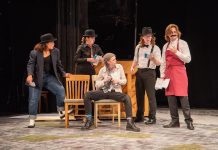For special education major Dawn Emmons, the most memorable aspect of being a student teacher was when students showed they understood what she taught, like when she taught math to a girl who was a grade-level behind.
“One day, she stopped me and showed me how to do the problems without me having to teach her again,” Emmons said. “Moments like those are what being a teacher, even as a student, is all about.”
Emmons, a senior at Webster University, said teaching was always something she wanted to do.
“I chose special education because I babysat two autistic boys,” Emmons said.
That’s different from fellow student Lauren Grover, who started as a journalism major. About a week or two before classes were set to begin, she decided to change her major to education.
She said teaching has always been in her blood. Her mother and grandmother were both teachers.
“I’ve always kind of grown up in a classroom,” Grover said.
Grover is currently a student teacher for sixth graders at Nipher Middle School in the Kirkwood School District. She taught seventh graders beforehand. Her major tailors toward middle school and her subject specialty is English.
“You want to develop positive relationships with students that age (12 and 13), but you also sometimes have to be stern,” Grover said. “You can’t always be their best friend.”
Jan Willcox, director of apprentice teaching and field experience at Webster, said all students must adopt a variety of skills to be successful student teachers.
“They have to have a good sense of humor, flexibility, good social skills and good time management,” Willcox said. “It’s fine to be friendly, but you have to think about the education of the whole class. You can be strict, but you need to be fair.”
Emmons and Grover agree balancing both the student and the teacher aspects can be difficult. They work on assignments simultaneously for Webster and the school they teach at. They also have to do work for the state in order to get certified.
“I like to plan things ahead of time,” Grover said. “I found that with student teaching, you can’t do that all the time. Sometimes, things can change on the spot.”
Willcox works with many students as they get field experience. Unfortunately, there are students who have told her that, now that they’ve had the experience, they are convinced education isn’t for them.
“Those are heartbreaking experiences,” Willcox said.
There were times when Grover questioned whether or not teaching was something she really wanted to do. But she had massive support to help pull her back.
“I think having my mom be there for me and give me what I need to learn classroom management has always kept me coming back,” Grover said.
Willcox said being a teacher isn’t just an 8:30 a.m. to 3:30 p.m. job. There’s a lot of planning that goes into their classes the very next day and the meetings before or after hours. Emmons said the most important thing she learns from her students is patience.
“You have to understand your students, and that can take time,” Emmons said.
Emmons believes prospective educators must have drive and commitment. Coming in to work upset or moody will not fly, as it can affect the personalities of the students.
Grover did feel a little air of intimidation when she first began student teaching under the eye of a teacher with 15 years of experience.
“The students have had this teacher for most of the year,” Grover said. “As someone who came in halfway through the year, it was definitely a difficult adjustment.”
Willcox believes it can be hard for professional teachers to adopt an apprentice, as no one really knows what’s at stake for the students.
“It’s really hard for them (professional teachers) to give up that responsibility to those who are just learning to teach, no matter how good they are,” Willcox said.
Grover’s favorite moment came from a lesson she created that was a play on Pandora’s Box and tied to Greek mythology. The lesson involved her bringing in a box and having the class think of evils in the world, write those evils on pieces of paper, and put those pieces in the box. Grover then closed the box. Once that was done, the class then discussed symbols of hope so the evils could be set free.
“That’s something that seventh graders still ask me about even 4 months after it happened,” Grover said. “They ask me if I ever opened the box (to see what the students wrote down).”
The box remains closed to this day.



